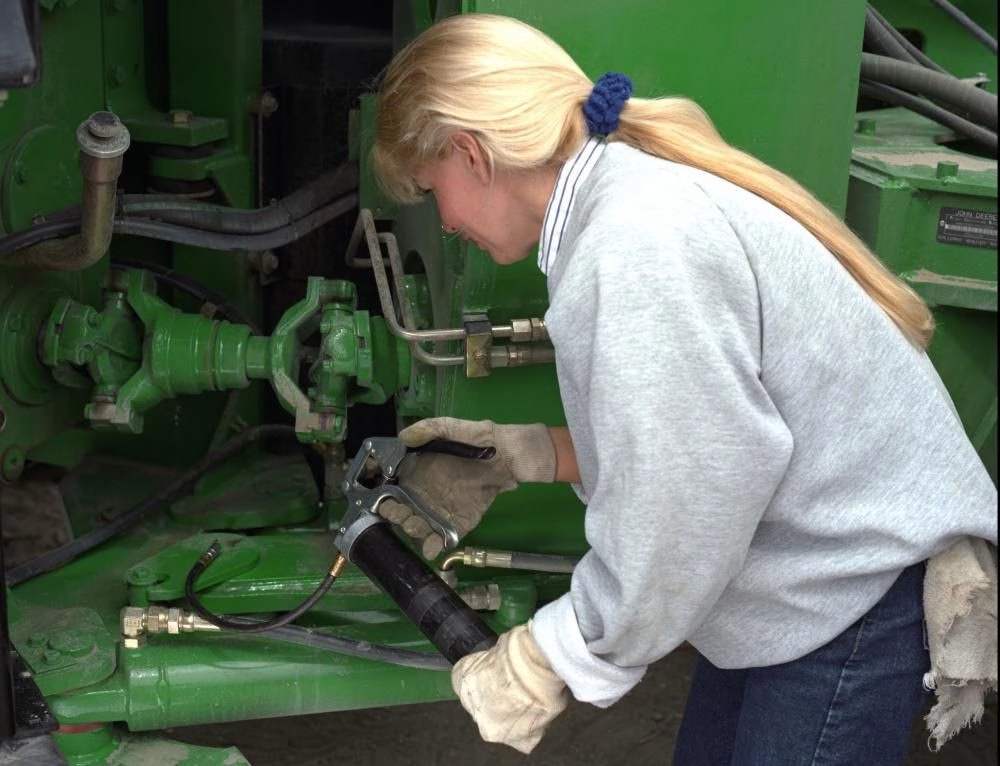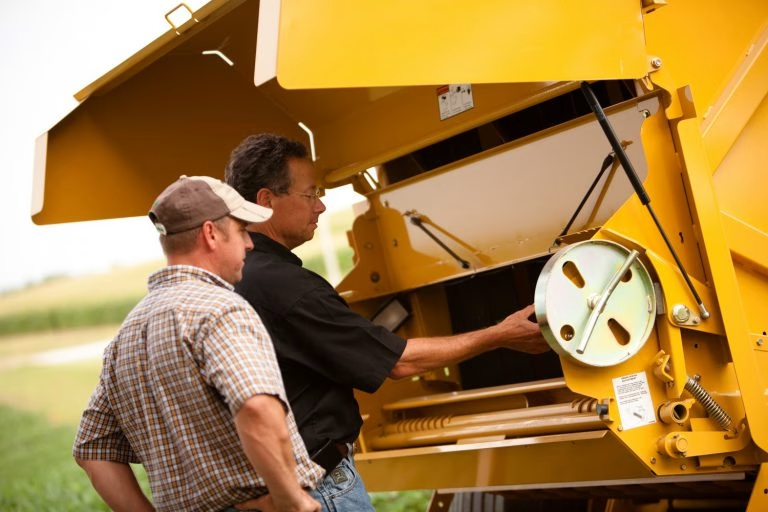7 must-know greasing tips for every dairy farmer! Boost your farm’s efficiency now.
Summary: Farm equipment is crucial for dairy farm operations, and proper maintenance is essential for smooth operation and reduced costs. Greasing is a crucial lubricant that forms a barrier between moving components, decreasing friction and wear. It is essential for agricultural equipment, which often runs under challenging environments like dusty fields and damp pastures. High-quality grease prevents additional wear and tear, frequent breakdowns, and increased costs. Greasing should be used at regular intervals for each type of equipment, such as tractors, implements, and milking equipment. Experts recommend oiling the workhorse every 10 hours, with a brief examination at the end of each day to identify any sections that need urgent maintenance. Balers, plows, and cultivators need lubrication every 40 to 50 hours, with plans for downtime or less busy seasons. Regular greasing eliminates expensive failures, increases the apparatus’s life, and leads to smoother operations and higher milk output. Essential tools for maintaining farm equipment include the grease gun, nozzles and fittings, and grease-fitting cleaning tools.
- Regular greasing prevents wear and tear, extending the life of your equipment.
- Knowing the right type of grease for each machine part is crucial.
- A consistent greasing schedule can avert unexpected breakdowns.
- Avoid over-greasing to prevent damage and inefficiency.
- Using the correct tools simplifies the greasing process.
- Troubleshooting common greasing problems can enhance overall performance.
- Daily maintenance routines are essential for optimal machinery health.

Consider farm equipment to be the heartbeat of your dairy company. Proper maintenance is more than just a good practice; it is a financial responsibility that can save you from costly repairs. Pay heed because these easy lubrication suggestions might spell the difference between a smooth-running farm and a string of expensive failures. Regular maintenance saves time and money, enabling you to concentrate on the most important—your cattle and output. Every dairy farmer should understand these fundamentals to keep the wheels working smoothly and the costs down.
Grease: The Unsung Hero Every Dairy Farmer Should Know About
Grease is an underappreciated hero in the agricultural sector. A grease is a lubricant that forms a barrier between moving components, decreasing friction and wear. This is critical for agricultural equipment, which often runs under challenging environments, ranging from dusty fields to damp pastures. With adequate lubrication, your equipment might succeed, resulting in expensive repairs and downtime that no dairy farmer can afford.
Grease kinds vary. General-purpose grease is popular, but specialty solutions such as high-temperature or water-resistant grease should not be considered. These are intended to endure certain circumstances, ensuring your equipment functions smoothly. For example, high-temperature grease is suitable for machinery that produces heat. Still, water-resistant grease is ideal for moisture-sensitive equipment.
It’s also essential to use high-quality grease. Cutting shortcuts here may result in additional wear and tear, not to mention frequent breakdowns. Investing in high-quality grease is a trivial detail. Still, it may significantly improve the life and performance of your equipment. Consequently, you’ll save money on maintenance and keep your operations operating smoothly, critical for maintaining peak milk output and minimizing total expenditures.
The Ultimate Greasing Schedule to Keep Your Farm Equipment Running Like New
When it comes to greasing your agricultural equipment, consider it a periodic check-up that may save you a lot of trouble in the long run. The key is consistency and understanding the appropriate intervals for each kind of equipment. Here’s a handy guide to help you out:
- Tractors: Most experts advocate oiling your farm’s workhorse every 10 hours. That may seem like a lot, but it becomes a doable routine when you consider how often tractors are used. A brief examination at the end of each day will reveal any sections that need urgent maintenance.
- Implements: Balers, plows, and cultivators typically need lubrication every 40 to 50 hours. Because these tools aren’t constantly used, you may plan maintenance for downtime or less busy seasons.
- Milking Equipment: Because your dairy farm milk cows three times a day, you must keep your equipment in good working order. Grease fittings and bearings at least once a month, modifying them according to the manufacturer’s recommendations and your unique use.
Pro Tip: Create a lubrication regimen that integrates into your routine. This might include scheduling certain days for various equipment or incorporating chores into your workflow. For example, you may set aside Monday mornings for tractor inspections and Fridays for implements, ensuring that no equipment is ignored.
Regularly greasing your equipment has several benefits. It eliminates expensive failures, increases the life of your apparatus, and leads to smoother operations and higher milk output. By devoting a few minutes daily or weekly, you may prevent hours of downtime and costly maintenance, allowing your farm to run more efficiently and profitably.
You Won’t Believe How This Simple Trick Keeps Your Tractors Running Like New!
Okay, let’s get down to the nitty-gritty of greasing critical components of your equipment. First, ensure that your grease gun is in excellent working condition. Whether manual or pneumatic, it’s your best buddy for this work.
When adding grease, a little effort goes a long way. Clean the grease fitting to prevent dirt and grime from entering and causing wear. Now, connect the grease gun to the fitting. Give it a strong pump or two, but be careful—over-greasing may be as harmful as not greasing. Generally, that’s typically enough if you see the old oil leaking out.
Some areas of your tractor or equipment are simple to access, while others are more difficult. An extension hose for your grease gun might be a lifesaver in difficult-to-access areas. If you need to target an area behind a shield or beneath a chassis, don’t be afraid to utilize a flexible hose attachment. It enables you to apply the grease precisely where needed without twisting yourself like a pretzel.
Always remember the effectiveness of a decent flashlight or headlamp. Recognizing what you’re doing is half the fight won. While at it, check for leaks or worn components that may need your attention.
Remember, consistency is essential. Stick to your lubrication plan; your equipment will repay you with fewer problems and a longer lifespan. So, the next time you’re in the barn, take a minute to lubricate the fittings—a minor effort with excellent results.
Avoid These Costly Greasing Mistakes to Keep Your Farm Gear Running Perfectly!
- Over-Greasing: One of the most typical blunders is to use too much oil. Excess grease may cause seals to crack and attract dirt and grime, resulting in premature wear. To prevent this, use a calibrated grease gun and adhere to the manufacturer’s suggested quantities.
- Under-Greasing: Under-greasing is just as bad. Inadequate grease application causes inadequate lubrication, resulting in increased friction and wear. Please establish a maintenance plan and strictly adhere to it to ensure all equipment components get appropriate grease.
- Using the Wrong Type of Grease: Not all greases are identical. Using the incorrect kind might result in poor lubrication or even harm your equipment. Always check your handbook for the appropriate type and talk with your supplier to ensure you obtain the right product.
- Ignoring Cleanliness: Dirt and debris may quickly enter grease fittings if not cleaned before adding grease. This may result in contamination and damage to internal components. Make a practice of wiping off fittings before greasing.
- Not Checking Grease Fittings: Broken or blocked grease fittings might prevent grease from reaching essential components. To maintain appropriate lubrication, examine fittings regularly and replace any broken or clogged.
- Skipping Hard-to-Reach Areas: While it is tempting to avoid problematic places, every component needs proper lubrication. Use extension hoses and couplers to access these locations easily.
The implications of these errors vary from small equipment inefficiencies to complete mechanical breakdowns, resulting in expensive repairs and downtime. Dairy producers can keep their equipment working smoothly by avoiding common greasing mistakes and adhering to a disciplined maintenance program, eventually increasing operational efficiency and lowering maintenance expenses.
Essential Tools and Tips for Keeping Your Farm Equipment in Top Shape!
The appropriate tools are essential for keeping your agricultural equipment in top shape. The grease gun is vital to any proper lubrication regimen. A high-quality grease gun guarantees that you apply the necessary lubricant without creating a mess or waste.
I propose the Lincoln 1162, a pneumatic grease gun known for its durability and effectiveness in regular usage. If you prefer a manual alternative, the Alemite 500-E is a reliable choice that has lasted the test of time.
Nozzles and fittings also play an essential role. The LockNLube Grease Coupler has grown popular among dairy producers due to its leak-proof seal and simplicity of use. While basic Zerk fittings are trustworthy, investing in grease-fitting cleaning tools will save you time and eliminate clogs.
Maintenance of these instruments is critical to ensuring that they function correctly. Regularly clean your grease gun, particularly after using more robust greases. Check the nozzles and fittings for indications of wear and tear and replace them if necessary. Always store grease cartridges correctly to avoid contamination, which might introduce grit and cause early mechanical failure.
Equip yourself with this vital equipment and the expertise to maintain it. Your greasing regimen will become much simpler and more successful.
Let’s Troubleshoot Some Common Issues You Might Bump Into with Your Greasing Process:
Even the best routine can run into snags. So, let’s troubleshoot some common issues you might bump into with your greasing process:
Identifying Greasing Problems
First off, be on the lookout for these tell-tale signs:
- Noisy Bearings: If your bearings start making noise, it’s usually a signal they’re not getting enough grease.
- Higher Operating Temperatures: Feel that heat? High temps are often a sign of under-lubrication.
- Grease Leakage: Do you notice excess grease around seals or on the ground? That’s an indicator that you might be overdoing it.
- Accelerated Wear and Tear: Equipment showing unusual wear patterns? It’s possible the grease isn’t reaching all the parts correctly.
Addressing Grease Issues
Once you recognize a problem, tackling it is the next step. Here are some practical solutions:
- Check Grease Fittings: Dirt and grime sometimes clog fittings, preventing grease from flowing where it needs to go. A quick cleaning could make a world of difference.
- Consistent Greasing Points: Stick to your greasing schedule. Consistency helps ensure that all parts get the attention they need.
- Use the Right Grease: Not all greases are created equal. Double-check that you’re using grease suitable for your specific equipment.
- Proper Grease Amount: Over-greasing can be just as bad as under-greasing. Follow the manufacturer’s recommendations for the correct amount.
Practical Tips for Daily Maintenance
To keep everything running smoothly, incorporate these habits into your daily routine:
- Regular Inspections: Take a few minutes daily to inspect fittings, seals, and other greased parts for signs of wear or leakage.
- Keep a Log: Maintaining a logbook of your greasing schedule can help spot patterns and preemptively address issues.
- Train Your Team: Ensure everyone knows the details of proper greasing techniques and the importance of sticking to the schedule.
By staying vigilant and proactive, you can nip most greasing issues in the bud, ensuring your equipment remains in top condition for the long haul.
The Bottom Line
When it comes down to it, maintaining your farm equipment well-greased is more than just a nice-to-have; it’s a need for peak performance and lifespan. Understanding the importance of grease, creating a proper greasing plan, avoiding common mistakes, and being prepared with the necessary equipment and information can help you keep your machinery in good working order, decreasing downtime and lowering the cost of repairs. So here’s a notion to leave you with. What if every farmer followed these measures seriously? Consider the overall influence on the farming community! It’s time to make regular lubrication and maintenance the rule rather than the exception. Your machine—and your wallet—will thank you.












